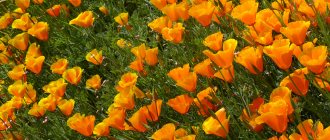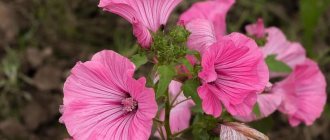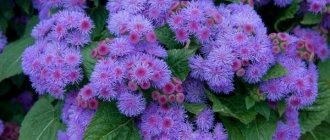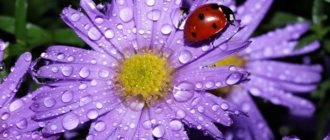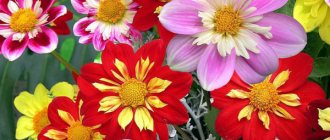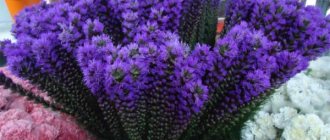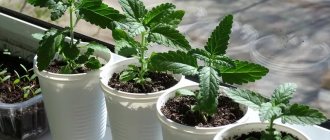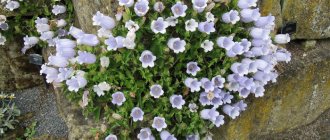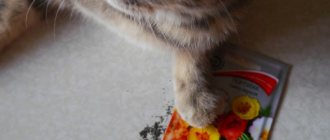Author: Elena N. https://floristics.info/ru/index.php?option=com_contact&view=contact&id=19 Category: Garden plants Published: February 10, 2019Last edits: November 03, 2020
- When to plant
- Growing conditions
- How and when to collect seeds
- Eschscholzia lobbi
The eschscholzia flower is a perennial golden-orange poppy, which is popularly called “wormwood” due to the similarity of the bluish-gray leaves of the plant with the dissected leaves of wormwood. And because of its overseas origin, one of the types of Eschscholzia is called California poppy.
Eschscholzia is becoming increasingly popular in our gardens. From this article you will learn interesting facts about this plant, and also get information about:
- what types and varieties of Eschscholzia are most popular;
- how to grow plant seedlings and transplant them into a flower garden;
- how to care for poppy plants during the season;
- how to collect seeds from Eschscholzia flowers and prepare it for wintering.
Planting and caring for Eschscholzia
- Planting: sowing seeds in the ground in October or April, but after stratification of the seed.
- Flowering: from June to October.
- Lighting: bright sunlight.
- Soil: dry, sandy, not too fertile, but well-drained soils of slightly acidic or neutral reaction.
- Watering: only during dry seasons.
- Fertilizing: before flowering, complete mineral fertilizer. Fresh organic matter cannot be used.
- Reproduction: seed.
- Pests: bean aphids, spider mites.
- Diseases: rot, powdery mildew.
- Properties: a medicinal plant, the use of which is not accompanied by side effects.
Read more about growing Eschscholzia below.
flowers (lat. Eschscholzia) , or California poppy , are a genus of the Poppy family, which includes about a dozen species native to Western North America. An old legend tells that when Spanish gold miners sailed to the shores of America in the 16th century in search of gold mines, they saw a golden glow 35 miles from the coast and, deciding that this was what they were looking for, rushed to the coast of California. How disappointed they were when it turned out that these were the golden fields of Eschszolzia. Since then, the Spaniards jokingly call this flower Copa de Ora - golden cup.
The plant received the name “Eschscholzia” in honor of the Russian naturalist, zoologist, doctor and botanist Johann Friedrich von Eschscholtz, who brought the flower from California to Russia. This plant is as beautiful and romantic as it is unpretentious, which is why it is gaining more and more popularity among flower growers, especially since eschscholzia blooms very profusely in a flowerbed from the beginning of summer until almost winter, and although one flower only lives for 3-4 days , it is immediately replaced by several more flowers and buds.
- Tulips - growing
Use in landscape design
California poppy is widely used to decorate garden plots, parks, and squares:
- planted in flower beds together with flowering plants of the same type;
- decorate borders;
- placed on alpine hills among stones, and decorative deciduous shrubs are planted between them.
Eschscholzia, the cultivation of which does not cause problems, is used to create flower arrangements and small bouquets. Bright flowers add decorativeness to flower beds and lawns. The main thing is to provide the plant with loose and dry soil and avoid waterlogging.
Botanical description
Eschscholzia is a herbaceous bushy perennial with a tap root, reaching an average of forty centimeters in height and grown in cultivation as an annual. The shoots of the plant are numerous and thin, bluish-green lacy leaves on long petioles are deeply dissected, cup-shaped single flowers up to 8 cm in diameter, simple or double, very similar to poppies, painted in white, yellow, orange, red or shades thereof . The peculiarity of Eschscholzia flowers is that they close in cold, windy, cloudy or rainy weather, as well as at night. The Eschscholzia fruit is a capsule measuring from 3 to 9 cm.
Secrets of success
Eschscholzia suffers from a lack of light; even in light partial shade it grows slowly and blooms sparingly. This plant should be allocated the most illuminated area with neutral or slightly alkaline soil. Acidic soil must first be limed.
Water the drought-resistant Eschscholzia once a week with water heated in the sun. It is better to time the procedure in the evening, when the flowers close.
The plant responds gratefully to loosening the soil and removing weeds. They feed it once a season during the budding phase. It is recommended to use complex mineral fertilizers.
Inset. The use of fresh organic fertilizers leads to burns of the roots and death of the plant.
Faded flowers and “extra” fruits must be removed immediately in order to prolong the flowering of Eschsholzia and make it more magnificent.
Growing Eschscholzia from seeds
How to sow seeds
Very often, sowing of Eschscholzia is carried out directly in open ground. When is the best time to sow Eschscholzia? If you sow it before winter, in October, then over the winter it will go through natural stratification, and in the spring you will see strong seedlings that will only need to be thinned out. And the autumn Eschscholzia will bloom faster than the one sown in the spring. If you have a reason to postpone sowing until spring, then put the seeds in the bottom drawer of the refrigerator until April - this way you will both preserve them and stratify them.
Before sowing Eschscholzia, identify a sunny area with dry sandy soil in the garden for it, then make shallow grooves in the soil into which sow small Eschscholzia seeds mixed with sand, plant them shallowly and mulch the area with peat to prevent hardening of the soil , which can prevent seedlings from germinating. Autumn planting is mulched with a thick layer of dry leaves.
Growing seedlings
Growing eschscholzia most often involves sowing seeds directly into the ground. But an interesting fact is that experienced gardeners prefer growing Eschscholzia seedlings, so we invite you to find out how this is done. As we have already written, this crop has a long rod-shaped root system, which is very easy to damage during transplantation, so it is best to sow the seeds in peat tablets.
Planting eschscholzia in tablets and caring for the crops is carried out in the following order: place the tablets in a plastic container and pour water into it, when the tablets absorb water, drain the remaining water, place one seed in each tablet using a wet toothpick, sprinkle the seeds on top with a small amount soil for seedlings, sprinkle the crops with water from a spray bottle and cover the container with glass or film.
The first sprouts will appear in about two weeks, then the glass is removed, the container with the tablets is transferred to a bright place and kept at a temperature no higher than 20 ºC. At this stage, caring for Eschscholzia consists of moistening the soil as needed and applying liquid mineral fertilizer for seedlings two weeks after emergence. Three weeks before planting in open ground, you need to begin hardening off the seedlings by taking them into a cool room for several hours during the day. Hardened seedlings after planting in the ground can withstand temperatures down to -5 ºC.
- Whitewashing trees in autumn: when and what to whitewash
Reproduction methods
Eschscholzia, like all representatives of the poppy family, reproduce well by seeds. Which are sown in early spring or late autumn.
Autumn sowing period
In the case of autumn sowing, poppy seeds are placed on frozen soil, literally on early snow, and they must be covered with a layer of fallen leaves. If you add the seeds earlier, before frost, when the soil has not yet cooled, there is a high probability that the seeds will germinate. In this case, young shoots will die when cold weather sets in. Do not be afraid to sow poppy so late; it even benefits the plant, since, after natural stratification, the poppy bush blooms much earlier.
Spring sowing period
For this sowing method, poppy seeds are subjected to forced stratification in the refrigerator for 1-2 months. After which, in early spring, in April, the seeds are added to the soil. Lightly sprinkle with sand and moisten the soil. To preserve moisture and create a greenhouse effect, the beds are covered with film. In a couple of weeks the first shoots will appear. At this stage, the greenhouse is removed, and only when frost returns are the young shoots covered again.
When 3-5 leaves are formed on a sprout, the sprouts are thinned out, removing weak and damaged ones. You should not thicken the plantings as this may affect the appearance of the bush.
In addition to directly sowing seeds in the ground, poppy seeds are sometimes sown for seedlings. To do this, use peat pots or tablets. Sow the seeds in moist, fertile, loose soil and cover with a greenhouse. After about 14 days, the first shoots will appear. After which, the seedlings are moved to a more illuminated place.
Before planting in a permanent place, the plant is subjected to a hardening procedure. The temperature is reduced by half. As a result of hardening, seedlings are able to survive even short-term frosts. Hardening is carried out gradually, starting from 20-40 minutes, gradually increasing the time.
Landing
Sow seeds in early spring or before winter, late autumn. In order not to confuse or miss the planting date, each bag of seeds contains detailed instructions on how and when to sow. It should be remembered that Eschscholzia seeds are quite small compared to other types of poppy. For this reason, when sowing, they are sprinkled with a thin layer of earth, sand or covered with mulch. The latter option is preferable, since the mulched soil will not harden after autumn precipitation.
There is no need to make special grooves, recesses, or pits. The seeds are too small and it is very difficult to distribute them evenly, at a sufficient distance from each other. They are scattered over the entire surface of the prepared area.
Under favorable conditions, the first shoots will appear within two weeks. Most of the seedlings are located quite close to each other. It is necessary to wait until 3-5 leaves form, after which weak, less developed shoots are removed. The distance between the bushes should remain about 10-15 cm.
30-45 days after the sprouts appear, you can admire the first flowers. Moreover, the “winter planting” of Eschscholzia blooms 2-3 weeks earlier than the spring sowing.
If the poppy was grown as seedlings, then holes are made in the flowerbed with a depth equal to the height of the peat pot or peat tablet. Place the seedlings into the holes along with the container. In this way, the young plant is protected from stress during transplantation and the fragile roots are protected from damage. The material of the peat pot is made of environmentally friendly materials - peat and wood. While in the ground, it gradually disintegrates, thereby fertilizing the soil. Peat pots will completely “melt” in about a month.
Planting eschsolzia
When to plant
So: Eschscholzia is planted in dry, sandy, well-drained soil with a neutral or slightly acidic reaction. If the acidity of the soil is too high, dig the area to the depth of a spade bayonet, adding 200 g of dolomite flour or two glasses of ash for each square meter. The timing of planting seedlings, depending on the climate in your area, is from April to the second half of May, when the threat of return frosts has passed.
How to plant
Before planting eschscholzia, dig small holes in the area at a distance of 30 cm from each other, since the bushes of the plant are quite spreading. The seedlings are placed in the holes along with peat tablets, sprinkled with soil, compacted, then the area is watered. Eschscholzia blooms from seeds 30-40 days after sowing.
Selecting a location
Before you set a day to plant your seeds, you need to decide where you will plant your California poppy. It should be a sunny area with dry, sandy soil. On the day of planting, it is necessary to make grooves in the soil into which the seeds will be planted. It is recommended to pre-mix the planting material with dry sand. The seeds should be sprinkled on top with a thin layer of soil, and then mulched using peat. This will help the soil not to harden, which means it will be easier for seedlings to break through. If you have autumn planting, then dry leaves should be used as mulch, and their layer should be quite thick so that severe frosts do not damage the seeds.
Eschscholzia care
Growing conditions
Growing eschscholzia flowers after planting in the ground consists of regular loosening of the soil and timely fertilizing. Eschscholzia needs to be watered only during very dry periods, but if the summer is normal, the plant will have enough moisture provided by the rains. To stimulate long-term and abundant flowering of eschscholzia, before it begins, a complete mineral fertilizer containing potassium, phosphorus, nitrogen and microelements or an infusion of ash in a ratio of 1:10 is added to the soil.
Never use fresh organic matter as fertilizer for eschsolzia - the plant may die from this.
If you are against self-seeding, which is how Eschscholzia intensively reproduces in the garden, then after the flowers wither, remove them along with the seed pods. After the plant has finished flowering, remove the old shoots - Californian eschscholzia will quickly grow new ones, which in 2-3 weeks will bloom more than ever.
Pests and diseases
As you can see, planting and caring for Eschscholzia flowers will not exhaust you, but both planting and caring for Eschscholzia flowers must be carried out in strict accordance with the rules of agricultural technology, otherwise you may encounter difficulties that you did not suspect. For example, at the beginning of summer, bean aphids can adhere to Eschscholzia, which is destroyed by spraying with the drug Komandor.
In hot summers without rain, the plant is attacked by spider mites, against which you will have to use a solution of the Actellik insecticide.
- Petunia without watering and picking (wick watering)
Excessive watering can lead to rotting of the roots and other parts of the eschscholzia; in this case, watering is immediately reduced and rotting areas are removed from the plants. If the damage is too strong, you will have to remove the diseased bushes entirely. In case of powdery mildew disease, the plant is treated with sulfur.
Properties of Eschsolzia
American Indians used the ground parts of Eschscholzia as a remedy for toothache, and Indian squaws considered pollen from flowers as a valuable cosmetic product. Pediculosis was treated with a decoction of flowers. Today in France, eschscholzia is grown as a raw material for the pharmaceutical industry, and in the United States of America, preparations from California poppy are used in pediatrics as an analgesic and sedative. The main advantage of drugs from Eschscholzia is the absence of side effects inherent in many benzodiazepine drugs.
Medicinal properties
This plant is known for its medicinal properties. The juice contains:
- flavonoids;
- coloring matter;
- alkaloids.
The above-ground part of the plant is used for production. It is cut during the period when flowering occurs, then dried.
Dyes are used to create cosmetics. Alkaloids can be used for medicinal purposes. They are used as sedatives and for pain relief. Alkaloids have an antispasmodic effect.
See also
Features and description of bush chrysanthemums of the Jordi variety, planting and careRead
Gelatin tablets, liquid extracts, and alcohol settings are prepared from this plant.
The use of Eschscholzia perennial as a medicine is recognized in traditional medicine. It is known that lotions with this remedy can help with toothache. Eschscholzia perennial can be used to combat insomnia. It is prescribed to children as a remedy for enuresis.
There are contraindications for the use of medicines made from this plant. They are not recommended to be taken:
- pregnant women;
- nursing mothers;
- for those who have a long-term allergy to Eschscholzia.
Children are advised to use such medications only as prescribed by a doctor. If an activity requires increased concentration, the use of a product based on this plant should be limited.
Eschscholzia after flowering
How and when to collect seeds
If you want to collect seeds for autumn or spring sowing, then don’t worry: the plant gives excellent self-seeding in the fall, and all you have to do in the spring is thin out the seedlings and wait for flowering. The seeds are needed exclusively to start breeding Eschsolzia or to share Eschsolzia with someone. If you need Eschscholzia seeds, put gauze bags on several wilted flowers and, as soon as the seeds are ripe, and this happens about a month after the end of flowering, cut the seed boxes wrapped in gauze from the bush, shake the seeds out onto a newspaper at home, dry them, Place in a paper bag and place in the bottom drawer of the refrigerator until spring. Properly collected Eschscholzia seeds remain viable for up to three years.
Eschsolzia in winter
Even perennial species of Eschscholzia are grown in our conditions as annual or biennial ones, so in the fall, before frost, dig up the area where Eschscholzia grew, removing plant remains. In the spring, even if you don’t really want it, you will again see strong, dense shoots on the site. Thin them out, add fertilizer to the soil, and in a month you will again be able to admire the delicate, tremulous beauty of the Eschscholzia.
Fertilizing
Timely feeding is the key to long and abundant flowering. Fertilizer application is a mandatory stage of care, especially if the soil is poor. Feeding should be comprehensive. The fertilizer must contain phosphorus, nitrogen, potassium and microelements.
Eschscholzia does not accept organics. A plant overfed with nitrogen most often dies. Unrotted manure can burn the roots.
Loosening the soil is an essential part of care, since the roots of the plant need air. Packed soil is not able to allow air to pass through, and therefore the plant may die. Sometimes inexperienced gardeners believe that eschscholzia dries out due to lack of moisture. In fact, this happens due to the lack of loosening of the soil.
Dried flowers of the plant must be removed from the bushes. This is worth doing not only to preserve the aesthetic appearance, but also to ensure that there are no chaotic crops on the site. The plant reproduces well by self-sowing. Seed material can be stored in the soil for six months. Therefore, you can cut off wilted flowers without waiting for the boxes to ripen.
Types and varieties
In our climate, Californian eschsolzia, soddy eschsolzia and, occasionally, lobba eschsolzia are grown in cultivation.
Eschscholzia lobbi
A low species up to 15 cm tall with light yellow flowers up to 2 cm in diameter.
Eschscholzia caespitosa
It also grows only up to 15 cm in height. Three times dissected thin leaves of bluish-green color, covered with a waxy coating, are collected in a rosette, above which rises a lush cap of bright yellow cup-shaped flowers up to 3 cm in diameter. This species blooms from June and almost until winter.
California Eschscholzia (Eschscholzia californica)
It resembles a wild poppy, which is why it is called California poppy. It is a herbaceous, branched, creeping perennial shrub up to 40 cm high. On the stem there are numerous thin ribbed shoots of a bluish-green color, on which there are three times dissected bluish leaves. The flowers are solitary, cup-shaped, up to 9 cm in diameter, yellow, white, cream, orange or carmine in color. Californian eschscholzia blooms profusely from early summer until the first frost.
The most popular varieties of Californian Eschscholzia:
- Strawberry Fields - bright red semi-double flowers at the edges turning yellow in the middle;
- double eschscholzia Peach Sorbet with delicate and lush cream flowers;
- Karminkoenig - a variety with simple flowers of a dark carmine color;
- Apple blossom - large, dense flowers with the color of the petals really reminiscent of apple blossoms;
- Eschscholzia Chiffon is a mixture of Eschscholzia seeds in a variety of colors and sizes that look great in lawns or borders. The height of the bushes is 35-40 cm, the flowers are double, with corrugated edges, yellow, hot pink, white, red - several shades in each flower. Blooms from May until frost;
- eschscholzia Ballerina Mix is also a mixture of varieties, consisting of both double and simple flowers of orange, yellow or pink, from 5 to 8 cm in diameter, the height of the bushes is 25-40 cm, the leaves are three times dissected with a waxy coating;
- variety Mikado - bushes 30 to 40 cm high with simple bright yellow flowers 6-7 cm in diameter with a large orange spot in the middle.
general information
Eschscholzia is grown by gardeners and avid summer residents all over the world. This herbaceous annual plant, with carved leaves, is similar in appearance to wormwood. The flowers of the varieties may be yellow. Beige and peach flowers with double petals were also developed by successful botanists. In nature, eschscholzia grows in North American fields and meadows, occupying usually infertile lands. The plant propagates by self-sowing.
Annual wildflower can be used in the home landscape
Arrangement of wildflowers at home
The flower is perennial if the temperature in the cool season is above zero or 0 °C. The culture blooms at the very beginning of summer and blooms until the autumn cold sets in. In structure, the plant is a close relative of the poppy, since its leaves contain healing substances. The seeds can be eaten, and the pollen is intended for use in cosmetology. The Indians, the original inhabitants of these regions, have used this poppy in medicine for centuries.
Eschscholzia variety "apple blossom" with delicate carved petals
A light-loving plant will decorate any flower bed
